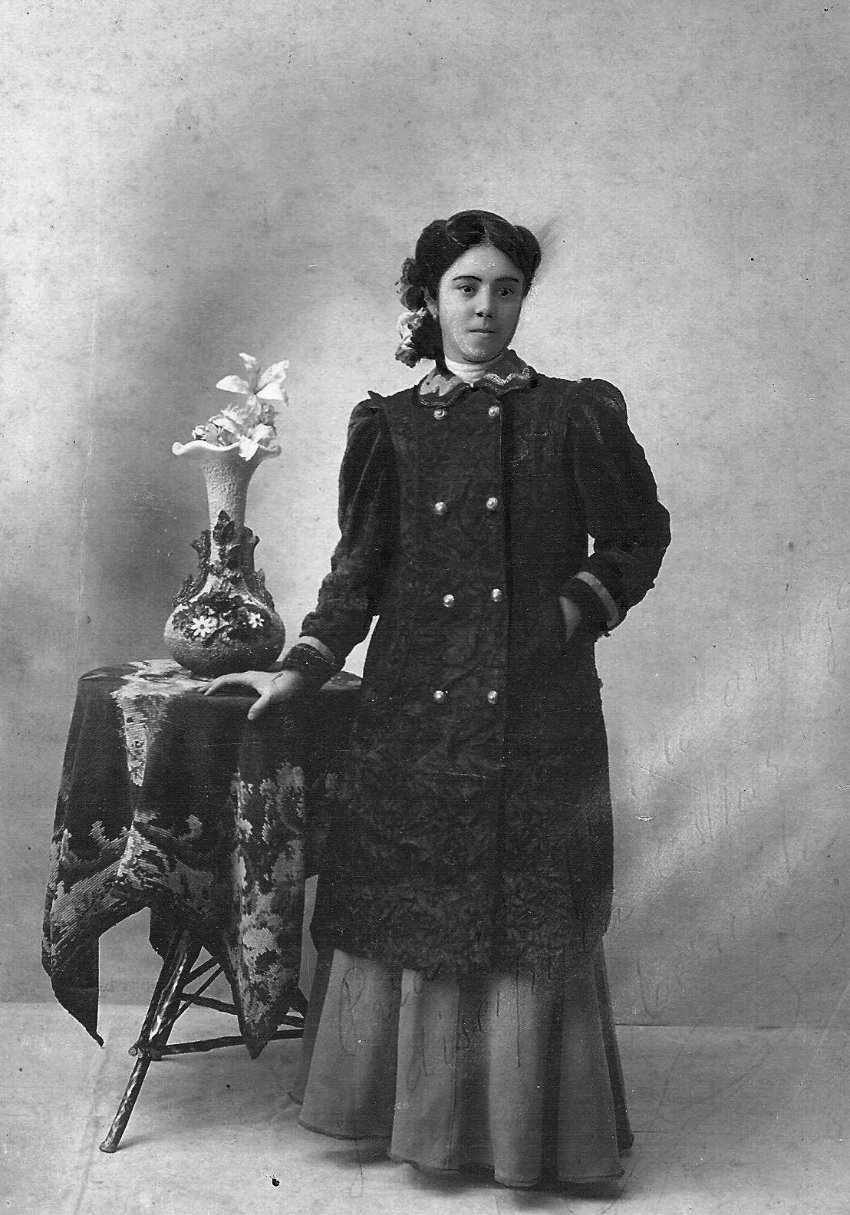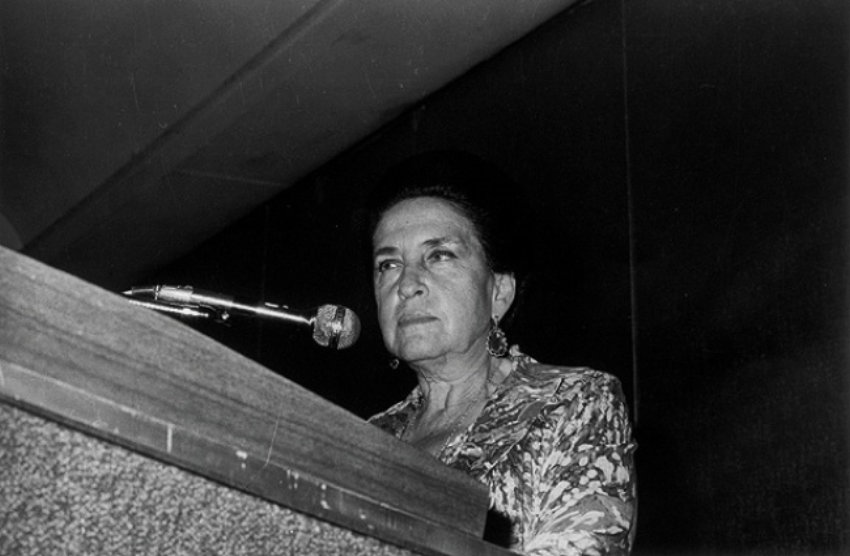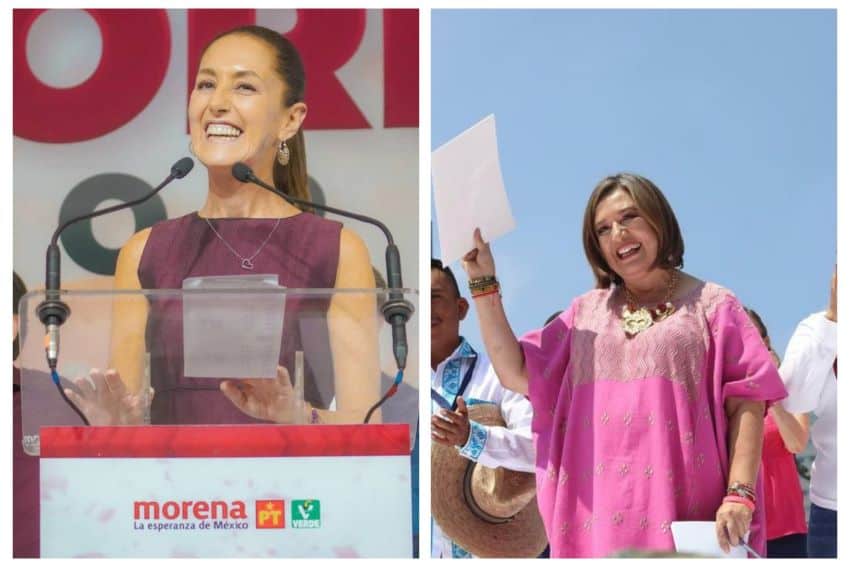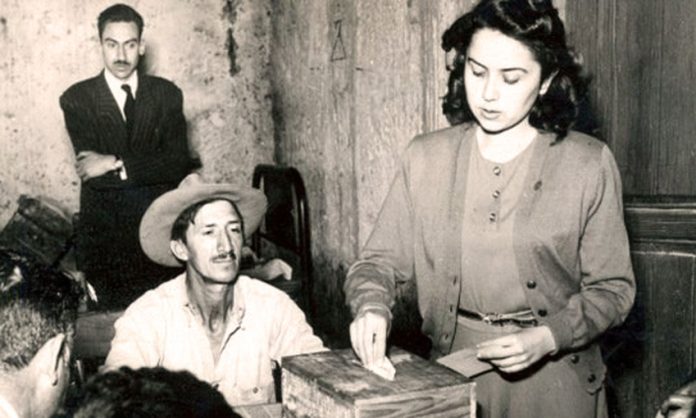Though there had been earlier stirrings for Mexican women’s right to vote, the immediate spark for suffrage in Mexico was struck by the Revolution of 1910. During the Revolution, women took jobs traditionally held by men; many fought alongside men in the war. The experience of the Revolution catalyzed women’s desire to participate equally in civic society and be a part of post-war efforts to define the future of Mexico. To do so, they would need to obtain full citizenship and the right to vote.
The First Feminist Congress is convened in Mérida, Yucatán

In 1916, women were granted permission to convene the First Feminist Congress in Mérida, Yucatán. The historic event was arranged by a well-respected private school teacher, Señora Consuelo Zavata y Castillo. The congress was attended by a total of 620 delegates, both men and women. Yucatán Governor Salvador Alvarado, an advocate for women’s rights, provided leave time for female teachers to attend and supplied them with train tickets and pesos.
What Zavata y Castillo didn’t anticipate was the degree of anti-feminist sentiment by the male delegates. One feminist attendee read a reform proposal written by prominent Mexico City feminist Hermila Galindo for the delegates to consider. The text, called “The woman of the future”, included sex education for women and divorce, which shocked the men. Galindo strongly argued that women must be empowered with an education and supported the proposal which laid the foundation of what would become part of the Constitution of 1917 such as state-sponsored secular education and equal pay.
In the last session of the congress, a proposal was made to modify the Yucatán Constitution to include women’s suffrage – Galindo didn’t feel the proposal went far enough in giving women the right to vote. Salvador Alvarado’s successor, Governor Felipe Carrillo Puerto – a revolutionary socialist – remedied that failure by proposing legislation to make women citizens and give them the right to vote in 1922 which was officially recognized in 1923. By 1925, two other states, Chiapas and Tabasco, joined Yucatán by allowing women to vote in party elections.
Women exercise their vote in Yucatán
Once women in Yucatán were given the right to vote, they elected women to office. Three women were elected to the state legislature and one woman to the Mérida City Council. All four were forced to resign their positions because the federal constitution did not allow women to hold office. Three decades of struggle would follow.
Several concerns shaped early opposition to women’s suffrage. Jocelyn Alcott, the author of “Revolutionary Women in Post-revolutionary Mexico”, says that opponents of women’s suffrage felt that “women would support Church-endorsed candidates subverting the anti-clerical regime.” There was also fear that they would abandon their role as mothers and caregivers and opponents felt they had a “superficial view of political issues,” Alcott says.
According to social scientist Victoria Rodriguez, the years “between 1916 – 1934 marked the rise of the women’s movement in Mexico, concerned almost exclusively with gaining the right to vote [nationally].”
Presidential support for suffrage brings hope to the movement

The election of President Lázaro Cárdenas brought hope to the movement.Cárdenas had advocated for women’s suffrage for years under the premise that it would benefit the nation. In 1937, women challenged the wording of the Constitution concerning citizenship eligibility – the Constitution did not specify men “and women” in granting full citizenship.
Amalía de Castillo Ledón, a columnist for the newspaper Excelsior, became a champion of political rights for Mexican women, organizing the Club Internacional de Mujeres (1932) and the Ateneo Mexicano de Mujeres in 1937 which led the battle for suffrage. Ledón later went on to become the first female member of a presidential cabinet and the first female ambassador serving in five different posts including Ambassador to the United Nations.
María del Refugio García ran for office in Uruapan as a candidate of the Sole Front for Women’s Rights. She won by an overwhelming margin but was not allowed to take her seat due to the wording in the Constitution. In response, she went on a hunger strike for eleven days outside President Cárdenas’ residence in Mexico City. Cárdenas ended her strike by introducing a change to Article 34 of the Constitution to grant full citizenship to women but it failed to get ratified.
Women achieve national suffrage
President Miguel Alemán continued the effort through legislative proposals in 1947 but failed. Upon assuming the presidency in 1953, one of Adolfo Ruíz Cortínes’ first measures was to reform the Constitution to grant women political rights, fulfilling a campaign promise to reform Articles 34 and 115.
Thirty years after women acquired the right to vote in Yucatán, women were finally decreed full citizenship with no restrictions, giving women across Mexico the right to vote and to hold political office. The long struggle took many years and involved many courageous women leaders, but women finally voted in their first federal election in 1955.
Women make steady progress as a political force

Following the enactment of suffrage, women started claiming seats in local government. Their activism in social and political grass-roots movements sent a strong message to federal authorities that they were a political force to be reckoned with. In the 1970s they became more actively involved in agrarian and labor movements. By 1979, the first woman was elected governor of a state when Griselda Alvárez Pónce de Leon became governor of Colima. In 1982, the first woman, Rosario Ibarra de Piedra ran for president. By the 1990s, women represented 63% of all registered voters.
In 2014, President Enrique Peña Nieto included a quota system to ensure gender parity of candidates put forth by political parties for federal and local legislatures in his electoral reform rules, further increasing the number of women in political office.
Women achieve gender-parity
Today, Mexico has reached gender parity in both chambers of Congress. In the 32 state legislatures, women hold 47% of the legislative seats. Nine of the 32 states have a woman as governor. This year saw Norma Piña become the first female chief justice of Mexico’s Supreme Court. The office of the presidency, however, remained elusive although six women have unsuccessfully run for that position.

In 2023, the two major candidates for president are women. Claudia Sheinbaum, the first woman mayor of Mexico City, will represent the Morena party and Xóchitl Gálvez, representing the Broad Front for Mexico coalition will be on the ballot next year. Both are engineers in their 60s.
After 100 years of struggle and setbacks, at this point in time, it looks like Mexico will have its first woman president in 2024. Another major step forward for women in Mexico.
Sheryl Losser is a former public relations executive, researcher, writer, and editor. She has been writing professionally for 35 years. She moved to Mazatlán in 2021 and works part-time doing freelance research and writing. She can be reached at A[email protected]
